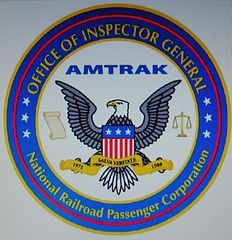Government Subsidized Public Transportation Is Fine If Administered with Common Sense
When possible, I like to take public transportation rather than drive, since it lowers my carbon footprint, and allows me to work en route. Also, all things equal, I like to support Amtrak, as my fare helps bring this system that much closer to profitability.
Amtrak is subsidized by the U.S. taxpayer. I don’t resent that; I think the federal government should support a public transportation asset whether it’s profitable or not. I do, however, expect some level of good sense in the allocation of these funds. I took an Amtrak bus last week from the train station in Santa Barbara to Union Station in Los Angeles, because the schedule was slightly better for me than the trains that run between the same two points. I was the only passenger out of 48 seats! That bus would have run, absolutely empty, had it not been for me.
Come on, how about a little common sense here? I don’t have a problem with your spending our money, but please do it responsibly. As one example of what I’m sure are dozens: don’t run buses between train stations.


It seems to me that there is at least a partial solution to the empty bus problem on public transit systems.
First if there are no passengers at all, park the bus and pay the driver for his/her time.
If there are very few passengers, switch to a smaller more fuel efficient bus or van during low use periods. Use the heavy duty large cap buses for rush hour.
The carrying cost of a few extra appropriatedly sized buses must be balanced against the savings in fuel.
If a small van can’t pay for itself during off peak hours, I think that routes should be consolidated and service compromised.
Here’s a link that tells how wasteful and inefficient Amtrak really is. Seems it’s only kept alive to keep the unions happy.
http://www.city-journal.org/2012/22_4_snd-amtrak.html
I don’t know what to think, but I can tell you this: You can’t take Amtrak from Southern to Northern California, unless you don’t mind spending forever getting there. It’s an 11-hour train ride vs. a four-hour drive from my house. Who in blazes would do that? You can’t take Amtrak to Las Vegas, regardless of your level of patience, where untold millions of people go each year — and how many more WOULD go if they could get there by rail? It’s good from Washington DC to Philadelphia, New York City, and Boston; that’s about it.
Sorry to say, given that I have a friend (perhaps now an ex-friend?), who’s Amtrak’s VP Marketing. Sorry, Matt. 🙂
It may be that better planning and consideration for the needs of passengers would make Amtrak perform better financially.
When I was a kid, we, and other people, often traveled by train. I remember going from Manitowoc, Wis., to Baltimore by train when my parents sent me to stay with an aunt in suburban Baltimore to escape the polio epidemic in Manitowoc. My father accompanied me on the train from Manitowoc to Chicago, put me on the Capitol Limited to Baltimore, and tipped a porter to watch over me. It was a comfortable over-night trip on a Pullman and the dining car food was good. Like other Pullman birth travelers, I had to get dressed lying down. The only problem is that I hadn’t yet learned how to tie a tie; in those days, people dressed up for traveling and would never consider going out for the evening or downtown without wearing a coat and tie.
I read that during World War II, executives from the Manitowoc Ship Building Company rode from time to time by train from Manitowoc to Chicago for meetings. It was an easy, quick, convenient, and comfortable trip. One could ride to Chicago in the morning, do one’s business, and return in the evening. Because the train stations were downtown, there was no problem getting to one’s final destination.
Considering that train travel can be much more energy efficient than airplane travel, it’s too bad that for most of us, it is no longer practical.
Yes, my father would wear a necktie to get on a plane. Gone are the days.
The matter of using smaller busses during off-hours came up a few decades ago in Minneapolis. The (city-owned) bus company stated that it was a common suggestion and also stated why it wasn’t done.
Having smaller busses to use during off-hours increases investment costs and does not reduce labor costs. Therefore, on a strictly economic basis, it makes more sense to use large busses at all times, even at times when there are few passengers. The amount saved by using small busses during off-house would be greatly exceeded by the increased investment costs. Presumably the increased investment costs would include the cost of the additional vehicles, the cost of the space to store them, and increased maintenance costs.
Recently I checked to see whether it would be practical to use Amtrak to go from Albuquerque to San Diego. After checking, I couldn’t imagine actually doing it. It would be an over-night trip and cost more than flying. The real reason I checked was to see if I could get to San Diego without driving and without having to deal with the unpleasantness of flying resulting from invasive security checks and the bad service now provided by the airlines. Actually, I decided not to take the trip.